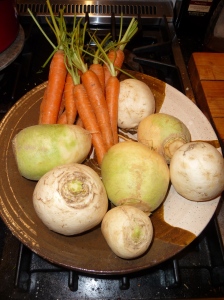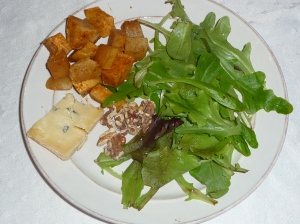
I don’t really know who makes these declarations — I hope they don’t clog up an already clogged Congress to get something like The Official Year of The Root Crop powered through — but it is, officially, somehow, The Year of The Root Crop. It’s a good thing, since little by little, we as a society are trying to drag ourselves back to the kind of eating that once made us one of the healthiest nations on earth only a few decades ago. For those who don’t already love vegetables; I’m sorry. I hope you can learn to enjoy them, as there are literally thousands of ways to prepare them, and with a little assiduous and open-minded work, you, too can get there. I have friends who only eat the white food groups, or the chocolate food groups, or the wine and beer food groups, so I do get it, but we continue to have people in for breadth of experience to say nothing of fun and laughter and conversation.
Among other things, I write for University of Maryland’s Grow It Eat It blog along with a lot of other gardener cooks, who have recipes for all kinds of seasonal veggies as well as pictures, tips on growing even a little bit of your own food — some of of have patio pots that produce cukes, lettuce, some carrots, whatever. Have a look. It’s a nice variety of people and ideas.
http://groweat.blogspot.com/#axzz2H76fhWGL
Now to the root vegetables: I didn’t grow them, but I’m eating them like crazy this winter. I get turnips (and carrots and more) from our friend, Theresa Mycek, the grower/manager of Colchester CSA, who lives just down the road and grows a fabulous selection of carrots, beets, turnips, and daikon radishes (and the proverbial more). http://www.colchesterfarm.org/

I’ve always loved vegetables, but I didn’t used to like turnips ONE BIT until I had some fresh from the ground – and not overcooked. Old, and overcooked they’re bitter and icky. Fresh and well cooked, they’re really good. Theresa grows three kinds of turnips – Purple Top, Hakurei, and Gold Ball. Purple Top, with pretty purple shoulders, is what we usually see in the grocery store. Hakurei is a white globe that’s crisp and slightly juicier and milder than the purple top, so in addition to being good cooked, it’s nice cut up raw in a salad or shredded in coleslaw like a radish. Gold Ball turnips have creamy, pale yellow flesh and are sweeter than Purple Top, especially when roasted.
Turnips (brassica rapa), which are relatively high in Vitamin C, are members of the same family as broccoli, kohlrabi (aka turnip cabbage), and rutabaga, (aka Swedish turnip or Swedes). The turnip itself is a large taproot, whose leaves are also edible. People over here on the Eastern Shore often stew the greens (which constitutes a mess of greens) with bacon or ham and some onions or sauté the young leaves.
Turnips take 40 to 65 days from seed to maturity, depending on variety. For example, Southern Exposure Seed Exchange’s fall-planted Amber Globe turnip is 63 days to maturity, while the spring-planted Nabo Roxo Comprido turnips reach maturity after only 40 days. Turnips are generally cool weather crops; you can sow seed practically as soon as you can get into the garden in spring. Succession plant if you want a steady crop until the heat sets in in June, then sow them again in August for fall and winter eating. You can actually grow turnips in containers too, being sure to thin them so they have sufficient space to grow. Below is a link to a list of turnip growing tips.
http://www.allotment.org.uk/grow-your-own/vegetables/turnips

I didn’t learn to enjoy turnips until I began to grow them myself. We’d usually steam and mash them with caramelized onions, parmesan and a little splash of cream, like rich mashed potatoes – and they’re delicious! Some roasted garlic adds a little dash of je ne sais quoi. But there are other ways to cook them. For Christmas this year, I roasted some in the pan with the leg of lamb along with potatoes, carrots and onions. Yum yum yum. Usually, though, I dice, season and roast them and keep them in the frig to pull out when I want. They’re delicious as a side dish with chicken or goose (or duck or whatever else your resident Visigoth drags home). More often, I pull a handful out of the container in the frig, warm them a little and add them to salad with toasted hazelnuts and blue cheese with a splash of pear or fig vinegar and olive oil.
To roast turnips:
Peel and dice turnips into whatever sized pieces you like. I usually do them about ¾ of an inch because they shrink as they roast, and I like to have the outsides toasty and the insides still soft. Others cut them small for a chewier texture.

Toss them with maple syrup or honey, salt, pepper and a bit of oil with whatever spices you like to add. I usually do either berbere spice or smoked paprika and Adobo. Curry’s nice too. Toast at 350F for about 35 minutes or until desired doneness.
For seed, you can check out:
http://www.southernexposure.com/
(Just to get your started).